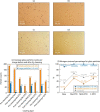Monolayer organic thin films as particle-contamination-resistant coatings
- PMID: 37452059
- PMCID: PMC10349057
- DOI: 10.1038/s41598-023-37813-7
Monolayer organic thin films as particle-contamination-resistant coatings
Abstract
Three organic monolayers coatings were developed and tested for their effectiveness to increase cleaning efficiency of attached microscale particles by air flows. The experiments were performed using silica substrates coated with these organic thin films and subsequently exposed to stainless-steel and silica microparticles as a model of contamination. Laser-induced-damage tests confirmed that the coatings do not affect the laser-induced-damage threshold values. The particle exposure results suggest that although the accumulation of particles is not significantly affected under the experimental conditions used in this work, the coated substrates exhibit significantly improved cleaning efficiency with a gas flow. A size-distribution analysis was conducted to study the adsorption and cleaning efficiency of particles of different sizes. It was observed that larger size (> 5-μm) particles can be removed from coated substrates with almost 100% efficiency. It was also determined that the coatings improve the cleaning efficiency of the smaller particles (≤ 5 μm) by 17% to 30% for the stainless steel metal and 19% to 38% for the silica particles.
© 2023. The Author(s).
Conflict of interest statement
The authors declare no competing interests.
Figures







References
-
- Bude J, Carr CW, Miller PE, Parham T, Whitman P, Monticelli M, Raman R, Cross D, Welday B, Ravizza F, Suratwala T, Davis J, Fischer M, Hawley R, Lee H, Matthews M, Norton M, Nostrand M, VanBlarcom D, Sommer S. Particle damage sources for fused silica optics and their mitigation on high energy laser systems. Opt. Express. 2017;25(10):11414–11435. doi: 10.1364/OE.25.011414. - DOI - PubMed
-
- Matthews MJ, Shen N, Honig J, Bude JD, Rubenchik AM. Phase modulation and morphological evolution associated with surface-bound particle ablation. J. Opt. Soc. Am. B. 2013;30(12):3233–3242. doi: 10.1364/JOSAB.30.003233. - DOI
-
- Qiu SR, Norton MA, Raman RN, Rubenchik AM, Boley CD, Rigatti A, Mirkarimi PB, Stolz CJ, Matthews MJ. Impact of laser-contaminant interaction on the performance of the protective capping layer of 1 & #x3C9; high-reflection mirror coatings. Appl. Opt. 2015;54(29):8607–8616. doi: 10.1364/AO.54.008607. - DOI - PubMed
MeSH terms
Substances
Grants and funding
LinkOut - more resources
Full Text Sources

